Page 342 of 526
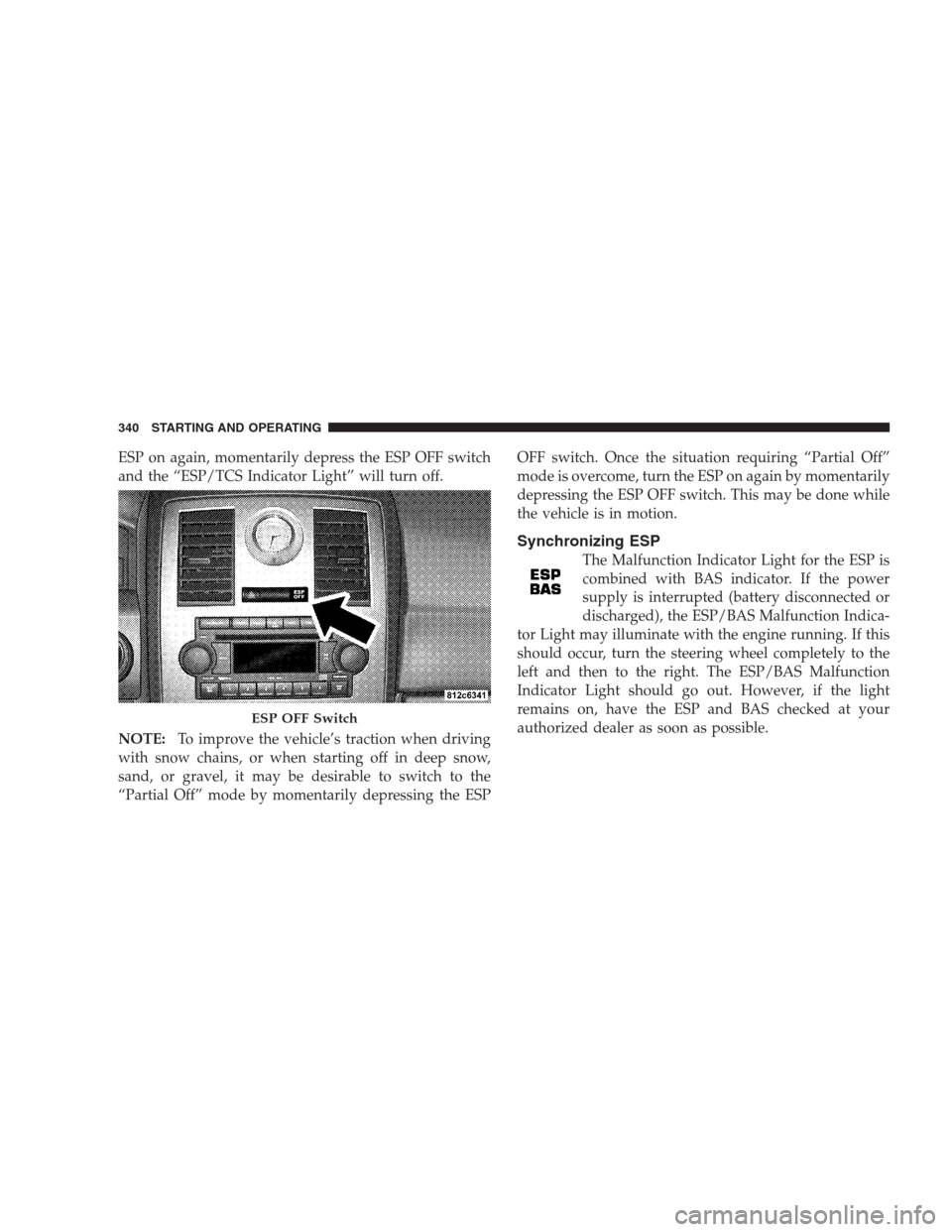
ESP on again, momentarily depress the ESP OFF switch
and the “ESP/TCS Indicator Light” will turn off.
NOTE:To improve the vehicle’s traction when driving
with snow chains, or when starting off in deep snow,
sand, or gravel, it may be desirable to switch to the
“Partial Off” mode by momentarily depressing the ESPOFF switch. Once the situation requiring “Partial Off”
mode is overcome, turn the ESP on again by momentarily
depressing the ESP OFF switch. This may be done while
the vehicle is in motion.
Synchronizing ESP
The Malfunction Indicator Light for the ESP is
combined with BAS indicator. If the power
supply is interrupted (battery disconnected or
discharged), the ESP/BAS Malfunction Indica-
tor Light may illuminate with the engine running. If this
should occur, turn the steering wheel completely to the
left and then to the right. The ESP/BAS Malfunction
Indicator Light should go out. However, if the light
remains on, have the ESP and BAS checked at your
authorized dealer as soon as possible.
ESP OFF Switch
340 STARTING AND OPERATING
Page 422 of 526
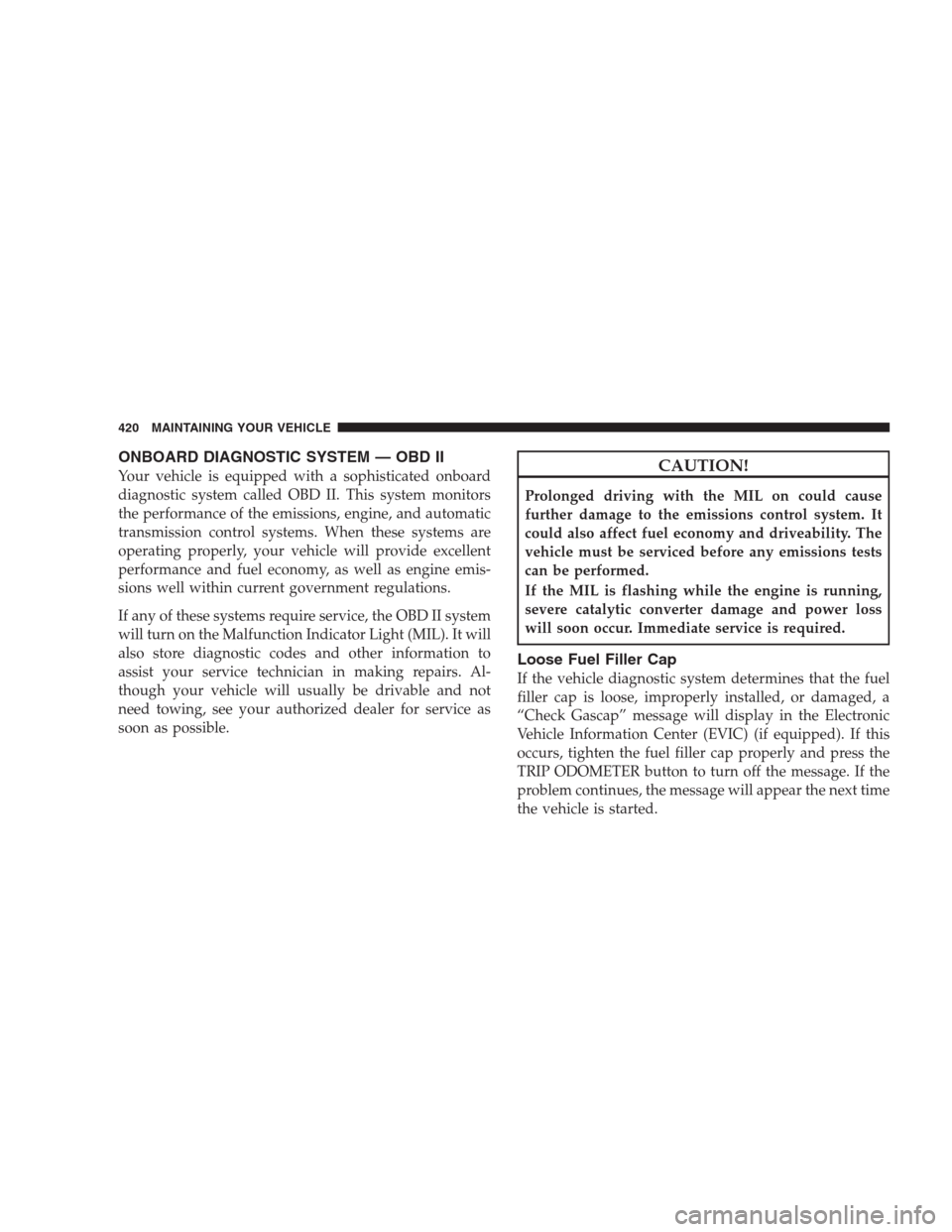
ONBOARD DIAGNOSTIC SYSTEM — OBD II
Your vehicle is equipped with a sophisticated onboard
diagnostic system called OBD II. This system monitors
the performance of the emissions, engine, and automatic
transmission control systems. When these systems are
operating properly, your vehicle will provide excellent
performance and fuel economy, as well as engine emis-
sions well within current government regulations.
If any of these systems require service, the OBD II system
will turn on the Malfunction Indicator Light (MIL). It will
also store diagnostic codes and other information to
assist your service technician in making repairs. Al-
though your vehicle will usually be drivable and not
need towing, see your authorized dealer for service as
soon as possible.CAUTION!
Prolonged driving with the MIL on could cause
further damage to the emissions control system. It
could also affect fuel economy and driveability. The
vehicle must be serviced before any emissions tests
can be performed.
If the MIL is flashing while the engine is running,
severe catalytic converter damage and power loss
will soon occur. Immediate service is required.
Loose Fuel Filler Cap
If the vehicle diagnostic system determines that the fuel
filler cap is loose, improperly installed, or damaged, a
“Check Gascap” message will display in the Electronic
Vehicle Information Center (EVIC) (if equipped). If this
occurs, tighten the fuel filler cap properly and press the
TRIP ODOMETER button to turn off the message. If the
problem continues, the message will appear the next time
the vehicle is started.
420 MAINTAINING YOUR VEHICLE
Page 423 of 526
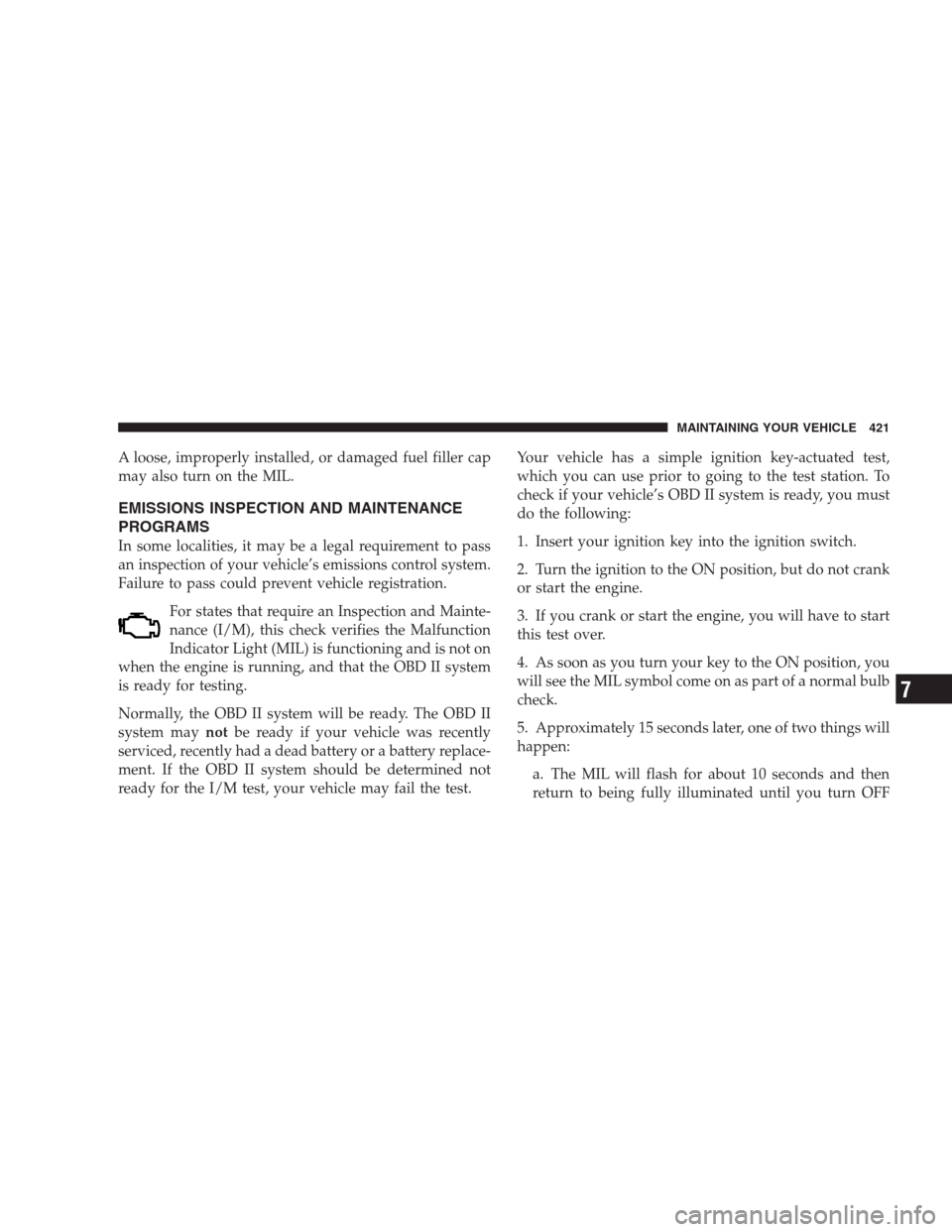
A loose, improperly installed, or damaged fuel filler cap
may also turn on the MIL.
EMISSIONS INSPECTION AND MAINTENANCE
PROGRAMS
In some localities, it may be a legal requirement to pass
an inspection of your vehicle’s emissions control system.
Failure to pass could prevent vehicle registration.
For states that require an Inspection and Mainte-
nance (I/M), this check verifies the Malfunction
Indicator Light (MIL) is functioning and is not on
when the engine is running, and that the OBD II system
is ready for testing.
Normally, the OBD II system will be ready. The OBD II
system maynotbe ready if your vehicle was recently
serviced, recently had a dead battery or a battery replace-
ment. If the OBD II system should be determined not
ready for the I/M test, your vehicle may fail the test.Your vehicle has a simple ignition key-actuated test,
which you can use prior to going to the test station. To
check if your vehicle’s OBD II system is ready, you must
do the following:
1. Insert your ignition key into the ignition switch.
2. Turn the ignition to the ON position, but do not crank
or start the engine.
3. If you crank or start the engine, you will have to start
this test over.
4. As soon as you turn your key to the ON position, you
will see the MIL symbol come on as part of a normal bulb
check.
5. Approximately 15 seconds later, one of two things will
happen:
a. The MIL will flash for about 10 seconds and then
return to being fully illuminated until you turn OFF
MAINTAINING YOUR VEHICLE 421
7
Page 433 of 526
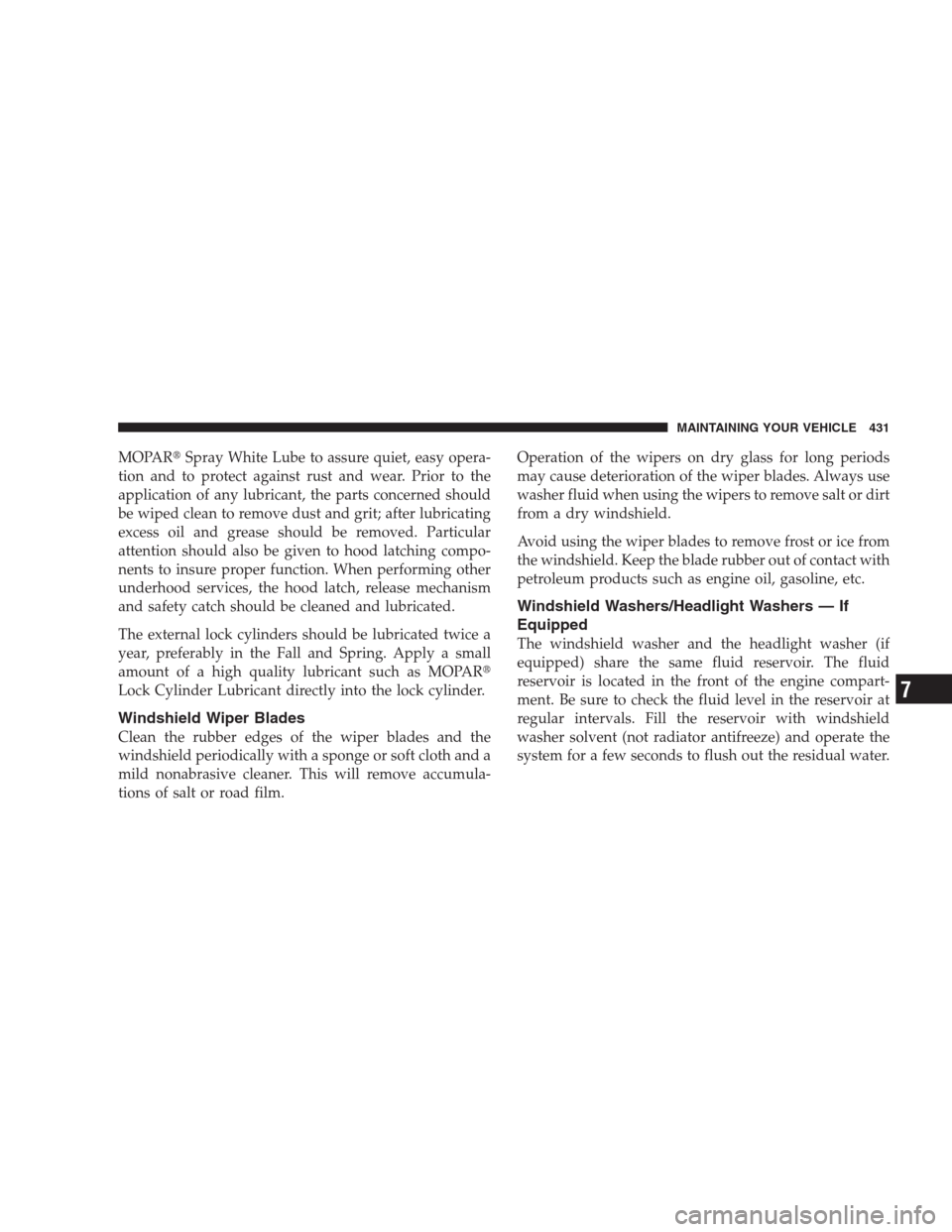
MOPAR�Spray White Lube to assure quiet, easy opera-
tion and to protect against rust and wear. Prior to the
application of any lubricant, the parts concerned should
be wiped clean to remove dust and grit; after lubricating
excess oil and grease should be removed. Particular
attention should also be given to hood latching compo-
nents to insure proper function. When performing other
underhood services, the hood latch, release mechanism
and safety catch should be cleaned and lubricated.
The external lock cylinders should be lubricated twice a
year, preferably in the Fall and Spring. Apply a small
amount of a high quality lubricant such as MOPAR�
Lock Cylinder Lubricant directly into the lock cylinder.
Windshield Wiper Blades
Clean the rubber edges of the wiper blades and the
windshield periodically with a sponge or soft cloth and a
mild nonabrasive cleaner. This will remove accumula-
tions of salt or road film.Operation of the wipers on dry glass for long periods
may cause deterioration of the wiper blades. Always use
washer fluid when using the wipers to remove salt or dirt
from a dry windshield.
Avoid using the wiper blades to remove frost or ice from
the windshield. Keep the blade rubber out of contact with
petroleum products such as engine oil, gasoline, etc.
Windshield Washers/Headlight Washers — If
Equipped
The windshield washer and the headlight washer (if
equipped) share the same fluid reservoir. The fluid
reservoir is located in the front of the engine compart-
ment. Be sure to check the fluid level in the reservoir at
regular intervals. Fill the reservoir with windshield
washer solvent (not radiator antifreeze) and operate the
system for a few seconds to flush out the residual water.
MAINTAINING YOUR VEHICLE 431
7
Page 443 of 526
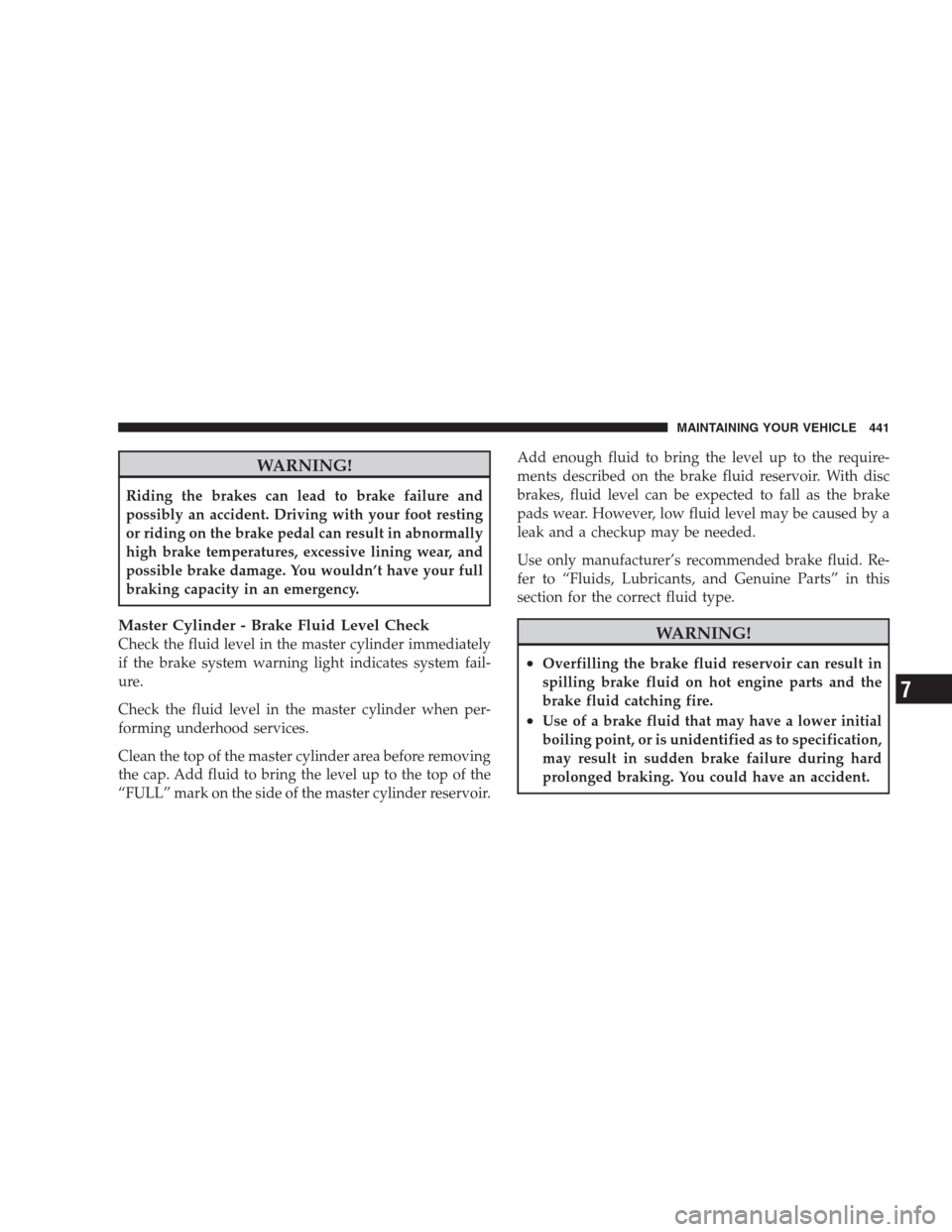
WARNING!
Riding the brakes can lead to brake failure and
possibly an accident. Driving with your foot resting
or riding on the brake pedal can result in abnormally
high brake temperatures, excessive lining wear, and
possible brake damage. You wouldn’t have your full
braking capacity in an emergency.
Master Cylinder - Brake Fluid Level Check
Check the fluid level in the master cylinder immediately
if the brake system warning light indicates system fail-
ure.
Check the fluid level in the master cylinder when per-
forming underhood services.
Clean the top of the master cylinder area before removing
the cap. Add fluid to bring the level up to the top of the
“FULL” mark on the side of the master cylinder reservoir.Add enough fluid to bring the level up to the require-
ments described on the brake fluid reservoir. With disc
brakes, fluid level can be expected to fall as the brake
pads wear. However, low fluid level may be caused by a
leak and a checkup may be needed.
Use only manufacturer’s recommended brake fluid. Re-
fer to “Fluids, Lubricants, and Genuine Parts” in this
section for the correct fluid type.WARNING!
•Overfilling the brake fluid reservoir can result in
spilling brake fluid on hot engine parts and the
brake fluid catching fire.
•Use of a brake fluid that may have a lower initial
boiling point, or is unidentified as to specification,
may result in sudden brake failure during hard
prolonged braking. You could have an accident.
MAINTAINING YOUR VEHICLE 441
7
Page 478 of 526
•Check the fluid levels of coolant reservoir, brake
master cylinder, power steering, and transmission,
and add as needed.
•Check all lights and other electrical items for correct
operation.
At Each Oil Change
•Change the engine oil filter.
•Inspect the brake hoses and lines.
CAUTION!
Failure to perform the required maintenance items
may result in damage to the vehicle.
Required Maintenance Intervals
Refer to the Maintenance Schedules on the following
pages for the required maintenance intervals.
476 MAINTENANCE SCHEDULES
8
M
A
I
N
T
E
N
A
N
C
E
S
C
H
E
D
U
L
E
S
Page 506 of 526
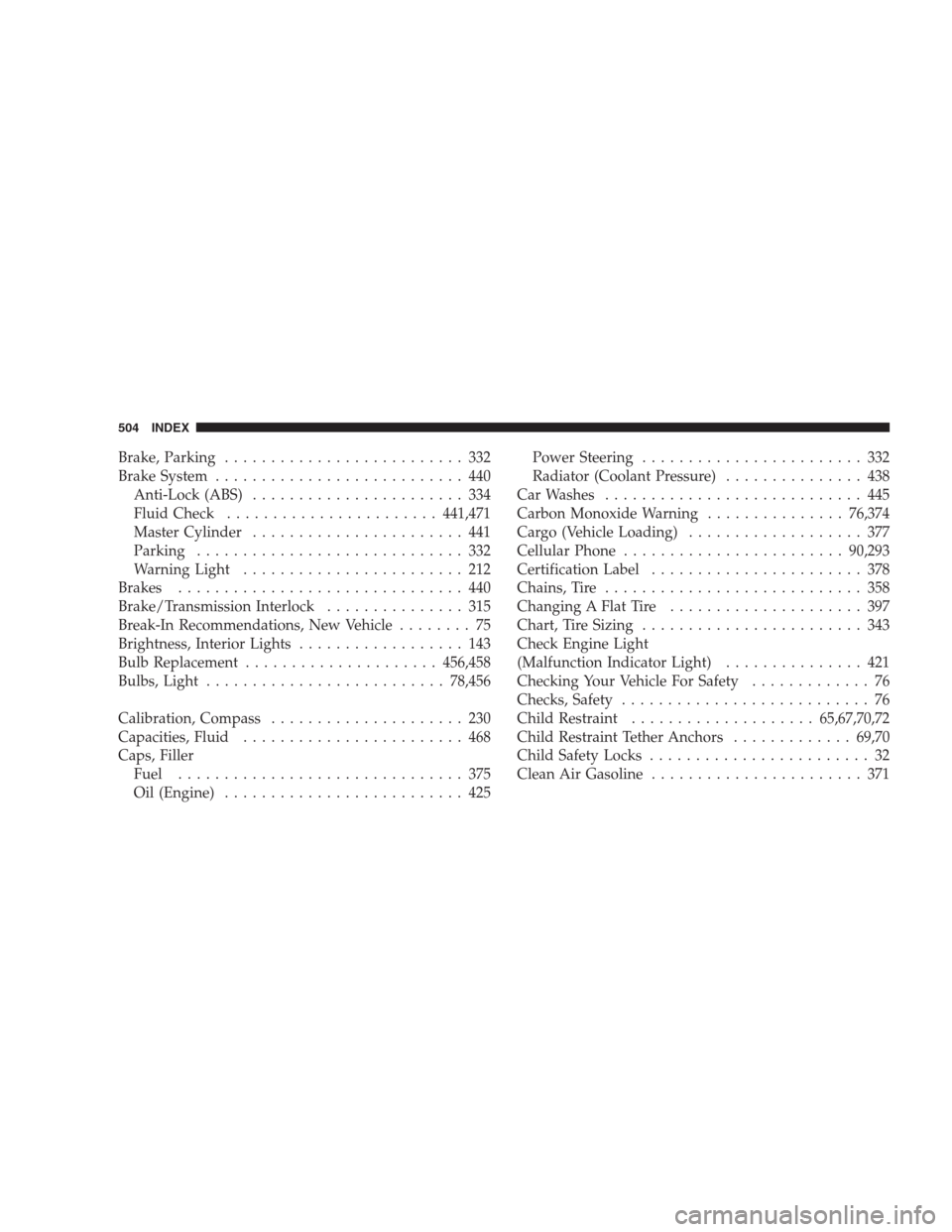
Brake, Parking.......................... 332
Brake System........................... 440
Anti-Lock (ABS)....................... 334
Fluid Check.......................441,471
Master Cylinder....................... 441
Parking............................. 332
Warning Light........................ 212
Brakes............................... 440
Brake/Transmission Interlock............... 315
Break-In Recommendations, New Vehicle........ 75
Brightness, Interior Lights.................. 143
Bulb Replacement.....................456,458
Bulbs, Light..........................78,456
Calibration, Compass..................... 230
Capacities, Fluid........................ 468
Caps, Filler
Fuel............................... 375
Oil (Engine).......................... 425Power Steering........................ 332
Radiator (Coolant Pressure)............... 438
Car Washes............................ 445
Carbon Monoxide Warning...............76,374
Cargo (Vehicle Loading)................... 377
Cellular Phone........................90,293
Certification Label....................... 378
Chains, Tire............................ 358
Changing A Flat Tire..................... 397
Chart, Tire Sizing........................ 343
Check Engine Light
(Malfunction Indicator Light)............... 421
Checking Your Vehicle For Safety............. 76
Checks, Safety........................... 76
Child Restraint....................65,67,70,72
Child Restraint Tether Anchors.............69,70
Child Safety Locks........................ 32
Clean Air Gasoline....................... 371
504 INDEX
Page 510 of 526
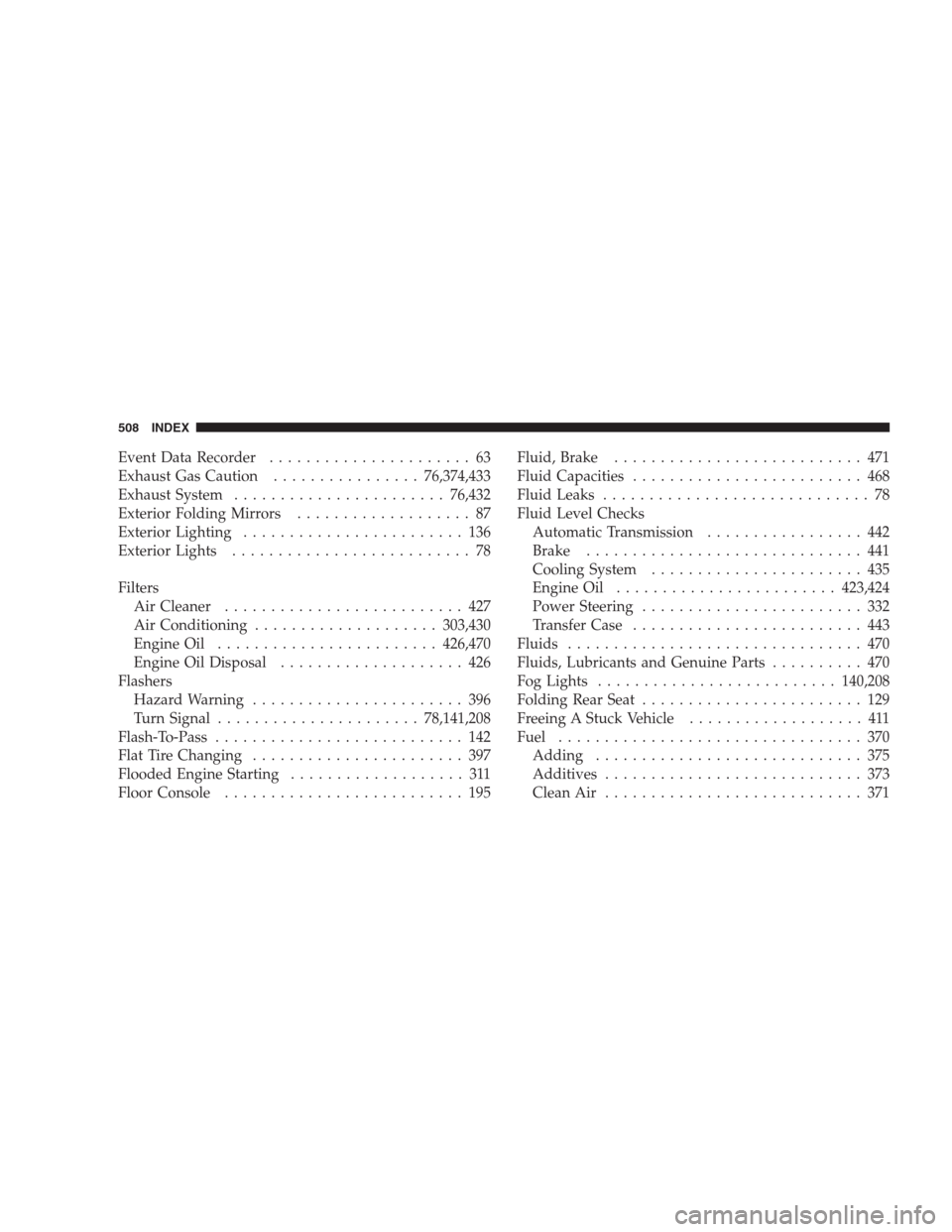
Event Data Recorder...................... 63
Exhaust Gas Caution................76,374,433
Exhaust System.......................76,432
Exterior Folding Mirrors................... 87
Exterior Lighting........................ 136
Exterior Lights.......................... 78
Filters
Air Cleaner.......................... 427
Air Conditioning....................303,430
Engine Oil........................426,470
Engine Oil Disposal.................... 426
Flashers
Hazard Warning....................... 396
Turn Signal......................78,141,208
Flash-To-Pass........................... 142
Flat Tire Changing....................... 397
Flooded Engine Starting................... 311
Floor Console.......................... 195Fluid, Brake........................... 471
Fluid Capacities......................... 468
Fluid Leaks............................. 78
Fluid Level Checks
Automatic Transmission................. 442
Brake.............................. 441
Cooling System....................... 435
Engine Oil........................423,424
Power Steering........................ 332
Transfer Case......................... 443
Fluids................................ 470
Fluids, Lubricants and Genuine Parts.......... 470
Fog Lights..........................140,208
Folding Rear Seat........................ 129
Freeing A Stuck Vehicle................... 411
Fuel................................. 370
Adding............................. 375
Additives............................ 373
Clean Air............................ 371
508 INDEX